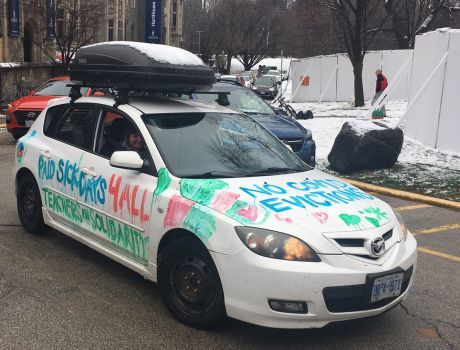Fight Ford!
You are here
Teacher solidarity fighting for a safe school reopening

January 21, 2021
Jen Reid is a Grade 3 teacher in the Halton District School Board and a member of the Elementary Teachers Federation of Ontario (ETFO). She is on the Executive of the Halton ETFO Local and the Chair of the local Political Action and Public Relations Committee (PAPR). She talks to SW/socialist.ca about how teachers are organizing both within and outside of teachers’ unions.
With the return to classroom teaching in the fall of 2020, my school and classroom were not the worst in terms of health and safety compared to many other teachers in the province. But like many others my workload suddenly increased: I had to shift all planning, programming, and curriculum with very little notice.
And though the kids are so happy to be back in class, and we are so happy to be back with them, we are with them 100 per cent of the time, with no assemblies, filed trips, or any of the pre-COVID breaks in our teaching time to prepare. Luckily, we have had no cuts to Educational Assistants, but still our workload has increased as a result.
The biggest thing the pandemic has highlighted is what we already knew before it hit: classes need to be smaller. Now the pandemic has shown that classrooms are too small for distancing, but the number of students was already too big for teaching.
Pandemic online/hybrid teaching is not the answer either: the emergency measures shouldn’t become a permanent feature of education after the pandemic.
An Ontario-wide forum was held in early December on the problems with the hybrid classroom/online model by Ontario Educational Workers United (OEWU). This is a grassroots coalition of individual education workers in the whole field of education and education activists across Ontario (though mainly centred in Toronto and Peel). They also submitted a petition to the Ministry of Education for more funding and produced a Toolkit for a Safe September.
Organizing and unity
OEWU was formed in August 2019 and built support for the teachers’ strike that preceded the pandemic. It has some union support and some support from parents, through the Parents’ Action Network.
The provincial section of ETFO also held a Town Hall and a survey about pandemic workplace conditions. These are great steps, but local organizing by teachers, students and parents is key.
In addition to my official role as Chair of the Halton ETFO local’s Political Action and Political Relation Committee, in the summer of 2020 I also decided to take action as a concerned teacher in my region: I was part of starting an ad-hoc “Concerned Teachers Group.” We held a local meeting of 25 people in August and though we didn’t get what we wanted right away for a safe return to the classroom we formed an ongoing group: “Halton Education Workers Strong” (HEWS), which has well over a 1,000 members on Facebook.
HEWS is connected to OEWU Ontario-wide, and both are connected to ETFO. It’s a very dynamic energy locally. For example, when they amalgamated all these self-contained classes and somebody posted it on the Facebook HEWS group (a closed group), I wrote immediately: “everybody start writing emails to the trustees.” The trustees can be allies, and they can get in touch immediately with senior admin.
2021 Ontario lockdown
Just before the winter break, 13 schools in the Toronto/GTA area shut down due to outbreaks. Now, all are suddenly shifting back to virtual teaching in the New Year, at least until January 25.
It remains to be seen what this will mean for teacher workload and teacher support, but also for support for parents and families, for kids with special needs, and the impact on mental health and quality of education – and what it will mean for a truly safe return for all next time around.
But again, the key will be organizing unity amongst teachers, parents, students, and the community.
On Saturday January 2, OEWU held a protest to demand more pandemic support for families: education workers converged on Queen’s Park in a honking car caravan around the legislature calling on the province to provide financial help to parents, students and workers faced with the challenges of the school closures.
This is the kind of solidarity and pressure that needs to continue.
To find out more about Ontario Education Workers United see: https://www.facebook.com/oewupage/
Section:
Topics:










